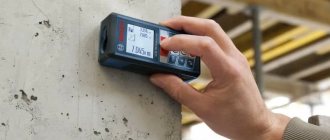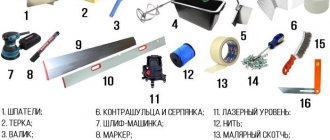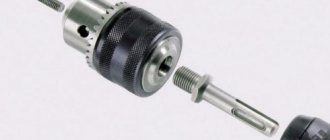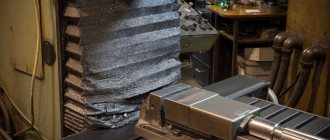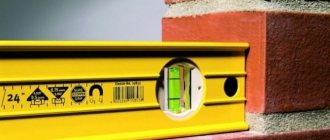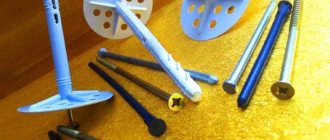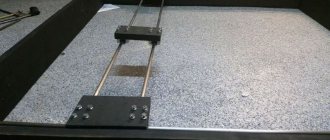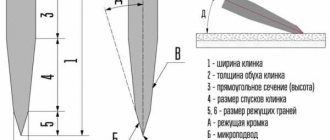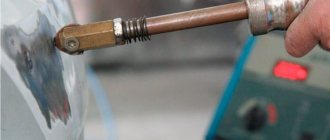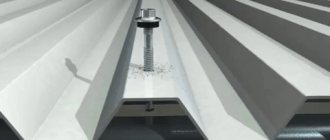Read in this publication: Laser tape measure: design and principle of operation How to choose a laser tape measure: capabilities decide everything How to choose a laser rangefinder: what to look for
Measure seven times and cut once. This is what folk wisdom says, which allows you to carry out work on manufacturing something accurately and without errors. This is precisely why such a measuring instrument as a tape measure was created - during its existence it has undergone a number of significant changes. In the old days it was an ordinary measuring stick, in the age of mechanics it took the form of a twisted tape, and in our age of electronics it is a small device that works on the principle of reflecting a focused light flux (laser beam). Laser roulette is distinguished by high accuracy and wide capabilities, which will be discussed in this article. Together with the site stroisovety.org, we will understand the design and operating principle of this measuring instrument, study its capabilities and selection criteria.
How to choose a laser tape measure photo
What is a rangefinder
Laser rangefinders are optical instruments that are used to measure distances during geodetic, land management and construction work, and mine excavation.
The laser beam passes through the optical system and, after reflection from the target, is recorded in the device. Knowing the time that elapses between sending the beam and receiving the reflected beam, the device calculates the distance traveled by the light.
This measurement method is very accurate and at the same time fast (ultrasonic clamps over long distances have a clear delay in obtaining a measurement, laser clamps give results almost immediately).
The entire mechanism is hidden in the case - the only visible element from the outside is the button that activates the laser, and, of course, the display showing the result. Everything else is optional and not related to the accuracy of the rangefinder.
Laser rangefinder accuracy
Laser rangefinders, when measured correctly, allow measurements to be taken with very high accuracy - down to the millimeter.
The accuracy of the rangefinder depends on several factors that you should be aware of:
- Range - the larger the range, the greater the possible deviations from the value indicated by the rangefinder. Firstly, this is due to the theoretical possibility of disruption of the light path, but more often due to the difficulty of accurate alignment - all errors become larger the further the distance at which the measurement is made increases. The range of most construction devices does not exceed 40-80 meters and for most applications this is quite enough, although high-quality rangefinders can work with millimeter accuracy even in areas of 500 meters;
- Build Quality - The optical and measuring systems in the cheapest rangefinders are not particularly accurate, so choosing a rangefinder from a reputable company: Leica, Bosch, Stanley, DeWalt or Makita (these are brands from the leaders in the laser rangefinder industry) is generally a good idea. A better optical system means less interference in the beam path and thus increases measurement accuracy;
- Light spot size - a smaller option allows you to more accurately select the measurement location. This is important if you are not sure that the beam is perfectly perpendicular to the surface from which you want to measure distance. Of course, the spot size depends on the distance at which the measurement is made: ideal values are the spot size at 10, 50 and 100 meters, 6, 30 and 60 millimeters, respectively.
Millimeter precision is not always required, but is nevertheless usually the preferred choice - even due to the small number of operations that will need to be performed much more precisely.
By the way, choosing the best rangefinder will also affect the durability and other functional parameters of the device.
Dependence of technology on conditions
The rangefinder has two functional units: an emitter, which contains a laser diode, and a receiver. Due to the electromagnetic wave, a laser beam is generated. The wave itself is produced by the rangefinder, then it is reflected from the working plane, be it floors, walls, ceiling or another working side of the object. After this, it is returned to the receiver. Each wave has its own amplitude and length. The last indicator is initially known to the rangefinder calculator, so further calculations are made using the principle of adding all the wavelengths that have traveled to the object and back. After this, the given amount is divided in half. And if there is a “cut” wave, then its indicator is added.
Comparative characteristics of several laser rangefinder models.
The resulting figure is displayed on the device display. The measuring quantity, that is, meters or centimeters, is set according to personal requirements.
The rangefinder works well in closed spaces, since in this case the distances are small and there is no interference at all. As for nature, there are several factors that can create errors in work:
Sun. Often the color of lasers is red, so the brighter the surface, the less visible the end point
Why is this so important? Because the rangefinder must be able to process the signal, but it will be too weak, which can affect the accuracy of the readings. Therefore, in the dark, laser rangefinder readings are more accurate. Environmental pollution
The best option is if the work is carried out outside the city, since the air there is clearer. In conditions of gas or fog, again there is a risk of errors. Reliability of rangefinder mounting. Manual measurements are always accompanied by inaccuracies. Therefore, it is better to use a special tripod for measurements. By the way, many modern devices already have such an element as standard. Working surface. If the measured plane has a dark color or a rough structure, the beam will be absorbed. Therefore, for such purposes, a light surface is used, which, due to its smoothness and color, helps to increase the reflectivity.
Cheap or expensive
Good quality laser rangefinders are not cheap devices. The computing chips themselves are quite simple, but the optical system, although not complex in terms of the technology used, is an expensive element.
The price is also affected by the body, which must be correctly profiled and often reinforced, which also affects the price.
An option where you can try to save money is the extensive set of additional features that are not necessarily necessary for a given application.
Depending on the model, the list of options in the menu can be long and include:
- Calculation of area and volume based on measurements taken;
- Altimeter option (based on the properties of the Pythagorean theorem);
- Measuring tilt angles;
- Trigonometric functions;
- Memory of recently measured values (usually from several to several tens of units);
- Continuous measurement function.
Choosing a rangefinder that has all the necessary functions, but for which you do not have to pay extra for an excessively wide range of capabilities, is often difficult: theoretically, not all of these functions are used in construction, but they can be useful to varying degrees for surveyors, surveyors, and land managers.
Additional functions
- Display backlight - not found in all models. This function is necessary when working when there are bad weather conditions or the inability to get close to objects and structures, and therefore is an important parameter.
- Software for interacting with devices that have Bluetooth functionality for data transfer. This is necessary if you need to store a large amount of information. This feature allows you to work quickly and efficiently, saving time.
- The function of finding the area is available in many models. It makes it possible to do without a calculator. After measuring the length and width of the surface, the device independently calculates its area.
- The volume determination function is performed similarly to the previous one (the height is also measured in advance).
- Level - this function allows you to determine the deviation of the plane horizontally and vertically.
- Protractor - the ability to calculate the area of a triangle and its angles. In this case, three sides of the geometric figure are preliminarily measured. This function is good to use when you are dealing with non-standard rooms.
- Possibility of continuous measurement - the device works like a tape measure. To measure the distance, you need to move away from the desired object, and the device shows the distance. This feature ensures comfortable and efficient work. This device is called a laser tape measure.
- The ability to calculate parameters by measuring the angle of inclination ensures that values are calculated regardless of the presence of various obstacles between the object and the device. A laser rangefinder is used as a computing device. It must be directed to the highest point of the structure, then press the required function and get a calculation of the distance to it. This is done by measuring the length of the hypotenuse and the upper angle of the triangle.
- Many laser rangefinders allow you to make markings.
- Some models have a compass for determining directions.
- An interesting feature is the sound.
- Some devices allow you to find the maximum and minimum distance to an object.
- There is also a built-in so-called “painter function”. It measures and calculates the area of all walls in the room.
Once you have determined the features you need, you can think creatively about how to choose a laser rangefinder.
Measurement technology
Buying even the best rangefinder will not make sense if the measurement technique is incorrect. In general, the whole technology comes down to setting up the device so that the light beam falls perpendicularly to the control point, which, however, is not always easy.
First of all, you should install the rangefinder steadily - you can use a tripod for this. Handheld rangefinders without a tripod can only be used for rough measurements and short distances, so a tripod is an essential accessory when purchasing any rangefinder.
A spirit level is useful for determining the correct position, so in many cases it will be a good idea to buy a rangefinder with a built-in spirit level. Laser levels can also be used, but this is not an ideal system due to the potential for errors from both devices to overlap.
- Rangefinders with scopes are useful for measuring long distances - being able to fine-tune the beam when working alone is a big help.
- In places where there are no control points, additional tables should be used to make measurements.
- They can also be used for measurements that require high precision where the reference point is too small or has an unfavorable shape (such as poles with a circular cross-section or trees).
During measurement, do not touch the rangefinder so as not to disturb the precise adjustment.
Criterias of choice
It doesn’t matter whether you are looking for a model from a well-known manufacturer, or trying to purchase a budget analogue. When choosing, you will still be guided by the purpose for which the rangefinder is purchased, as well as the regularity of use. There is no need to purchase an expensive model if you do not plan to use it regularly.
Those who are planning to choose a laser tape measure should pay attention to the class of the laser, which directly affects the measurement distance. There are three classes:
- Class 2. They are found in rangefinders operating at distances up to 70 m. They are considered safe; a beam accidentally entering the eyes will not harm the retina.
- Class 2M. The beam power is higher, it works at medium distances and can damage the retina, but it makes it easier to take measurements outdoors, especially in cloudy weather.
- Class 3R. They work with rangefinders operating at 300-500 m and require the use of safety glasses.
Laser power affects the measurement range Source mosoblzhilservice.rf
Pulse or phase
The difference in measurement accuracy may be due to the mechanism used - phase and pulse rangefinders work slightly differently in this regard.
The former use a continuous harmonic wave as a meter, which improves the measurement accuracy, while the latter use only one frequency.
As a result, accuracy decreases, and the main advantage of pulse rangefinders is the ability to carry out reflectorless measurements.
From a mathematical point of view, using a phase rangefinder requires a lot of complex calculations, but it is beneficial where the main advantage is maximum accuracy.
